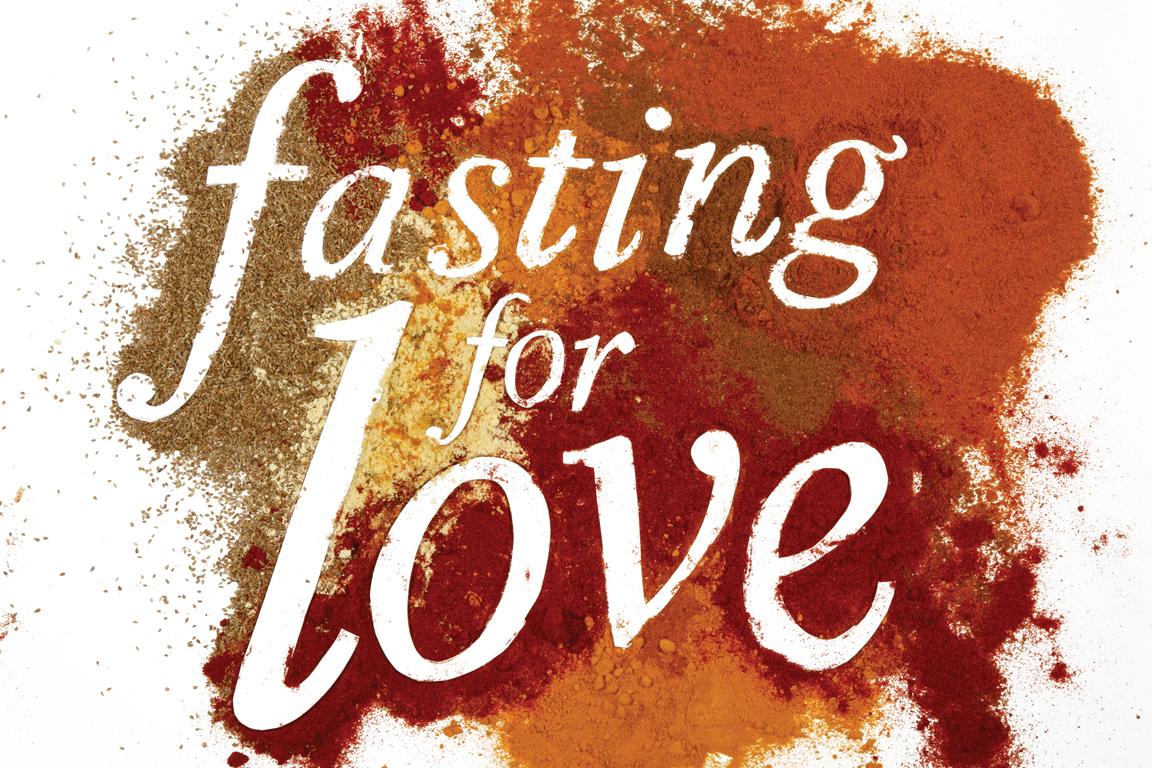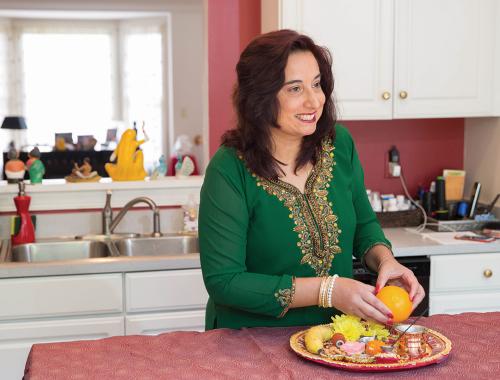Fasting Love
When the flame of an old tradition gets snuffed out, should it be rekindled — or reengineered?
By Monica Bhide, MS '93
Photos by Logan Werlinger

Karva Chauth, an Indian fasting custom that takes place in October or November, has always fascinated me. Each year as I was growing up, I would wait for it so that I could watch my mother perform all its rituals.
As a child, I would hide behind the door and observe her as she got ready for the occasion. Each year on Karva Chauth, she would get up early. I could hear her and my father cooking up a storm in the kitchen. Around 4:30 in the morning, she would eat puri (fried bread) and aloo (potatoes) and drink a cup of tea. While my father went off to work, my mother began her fast. The fast would last all day and required complete abstinence from eating or drinking. In the Hindu religion, this was a day for her to pray for her husband’s long life.
I loved the evenings, when it was time for her to break her fast. She would dress in all her finery and then ready her prayer plate (this is a beautiful plate filled with flowers, special desserts, a small terra cotta lamp and other things used during the prayers). We would all head over to a friend’s home for the prayers. There, all the married women in their gold and diamonds would sing prayers and exchange plates. All the little girls, like me, would look on in reverence and respect.
To my childhood eyes, the women resembled movie stars. How romantic it was that they prayed for their husbands in this way.
Once the prayer was over, we would head home for the final ritual. First, my father would drive around, for hours sometimes, trying to find a perfect sighting of the moon so that my mother could eat again. He’d smile at my mother and tell her that he was so grateful to her and happy that she could break her fast soon. My mother would observe the (almost always hidden) moon through a sieve and then touch my father’s feet in respect. He would then feed her freshly squeezed orange juice to break her fast. And in his own personal tradition, he would always have a gift for her as a thank you. Mom would smile and open the box, her eyes twinkling, and Dad would hold her. Afterward, we would all sit down to dinner.
Ah, true love, I thought.
As I grew older, I began to notice the custom’s prevalence in north Indian movies. I dreamed of the day I would be able to practice this with my husband. It seemed to be one of those things that would complete my transition to true womanhood.
I began planning weeks in advance. Since both my in-laws and parents lived in a different country, I knew there would be no one to help me decipher the customs here in the U.S. I was determined not to let that be an impediment to my perfect day, though. I researched as much as I could and called my mother many times to ensure that I had all the things that I needed.
The night before the big day, I prepared the puri dough. It was ready to be rolled out and fried the next morning. Ghee (clarified butter) scented with cumin became my base for making the aloo.
Finally the morning arrived. I awoke at 4 a.m. Before my husband could say good morning, all four
burners were going on the stove. Tea was simmering on one, aloo on the other, hot fried puris on another and warm kheer (rice pudding) on the last one.
I sat down at 4:30 and ate my meal with great pride. I was sure I was entering some secret of womanhood that had long eluded me. My husband merely smiled as he drank his tea.
Off to work her went.
I had taken the day off work, as I had heard I was supposed to do. In the morning, I got my hair and nails done. The afternoon was spent meticulously applying henna to my hands and feet. As I waited for the henna to dry, I remembered the days my mother would do the same.
Around 5 p.m., I decided to get "properly" dressed. I had researched and found that on festive days women should wear solah singar, or 16 adornments, on their body, and I now had all 16 of them. I wore my wedding lehnga (gown) to mark the occasion.
Since we were new to the area, I did not know other Indian families nearby and so had decided to do the prayer at home. I began with reading Sanskrit scriptures.
Then the wait began for the moon. It hid until almost 9. Finally, I caught sight of it. I ran inside and got my prayer plate along with the sieve and orange juice. It was time. I looked at the wondrous moon through the sieve, dipped my hand in the glass of water on the plate, just as my mother had, and sprinkled the water at the moon. I closed my eyes in prayer and then bowed to my husband in a scene reminiscent of an Indian movie.
Then, as if to mark a milestone, I took a sip of the orange juice. Ah, I thought, this is what a true married woman feels like. I had done it. I had fasted on this very auspicious day to pray for my husband’s long life. I was truly a devoted wife at age 24.
Just then, as if on cue, the phone rang. My husband answered. As he talked, his expressions changed from a smile to giggles and then to laughter. "It’s your mother," he said turning to me. "She wants to know if you are all set for the Karva Chauth fast tomorrow."

Having prayed for his long life on the wrong day, would I cause my husband’s early demise? I calmed myself down, eventually, but kept a special eye on my husband for months.
The following year, I rolled the bread, made the potatoes. I laid out my clothes for the night. But then a strange sense came to me of the old failure, and I suddenly felt unworthy— not good enough to defeat the god of death. I cried again. It’s a simple thing to not eat for a day, but I was carrying with it the burden of tradition and the past, and I felt myself crumbling under my own expectations. I had failed at it once, and the magic that I had grown up under seemed broken. I didn’t go through with the fast and ate solemnly.
After that year, on the day of Karva Chauth I could never shake that feeling. How could I even try? Would the fast even mean anything? I was young, an idealist—and an idealist doesn’t easily accept failing. When my friends would ask me if I observed Karva Chauth, I’d dodge the question. I avoided calling my mother on the fast day. I skipped invitations to end-of-day prayers, ashamed.
But as the years went by, I noticed that my husband did not love me any less. "I don’t understand how not eating for a day makes anyone a better anything, let alone a wife," he said one day as I lamented yet again at being unable to bring myself to fast.
It was then that I began to wonder about Karva Chauth. I asked friends why they fasted, and leaving aside insistent mothers-in- law and gifts at the end of the day, the answers boiled down to "It’s how it is; why change tradition?" For me, I realized that Karva Chauth was about wanting to feel that loving bond that I had seen between my parents. It was about belonging to that gorgeous group of Indian women who could do no wrong in their married life. It was about wanting to be the perfect wife. Could I only have those things brought to me by tradition?
One day, at the urging of my husband, I finally called my mother in India and confessed. The disappointment in her voice was piercing. "So, you are telling me that you eat on that day?" she asked quietly. She’s called me every year since to remind me when the fast is.
But it was after that day that I decided to start a new tradition: Each year, instead of a day of fasting and sacrifice, I turn the day of Karva Chauth into a day of nurturing. I begin preparations early in the morning as well, but instead of preparing for a fast, I prepare for a feast. I cook my husband’s favorite dishes, like lamb with green chiles and curry leaves, chile chicken with garlic and peanuts, rice layered with buttered sage and paneer.
"Mom, I am going to lay out the red plates so that everything looks like Christmas," my older child says. The house becomes festive, we fill vases with flowers, we dress in our best. But before we eat, we still wait for the moon to show itself.
We drive around, as I have seen my father do for so many years, until we find it. I no longer shy away in shame from the Karva Chauth moon; instead, I smile confidently. I look up at it, with hands folded in prayer, and pray that my husband’s dreams will always be touched with magic. After the moon sighting, my husband and I hold one another and my kids giggle at the scene. I am not sure they fully understand my tradition, but I know this: They feel what I felt years ago when I saw my mother and father embrace under the Karva Chauth moon.
A version of this story appeared in Monica Bhide’s collection of short stories A Life of Spice (CreateSpace, 2015). She is the author of the forthcoming novel, Karma and the Art of Butter Chicken (Bodes Well Publishing, September 2016), as well as three cookbooks and a 2014 short story collection (The Devil in Us). Her writing also has appeared in Food & Wine, Bon Appétit, Saveur, The Washington Post, The New York Times and the fiction anthology, Singapore Noir (Akashic Books, 2014). Ms. Bhide lives in Dunn Loring, Va., with her husband and two sons.
Other Summer Features:
The Fight and Fury of the Z-Man
Iconic photographer and eternal San Franciscan Michael Zagaris, BA '67, has shot rock gods and all-stars, stood up to The Man and almost died twice. He’s spent his life
doing everything you always wanted to do, and now that he’s getting older ... absolutely nothing’s changed.
Armies on the March
The ups and downs of a presidential campaign and the army of GW alumni along for the ride
'Google Maps' of the Miniscule
A new imaging facility brings the nanometer and atomic worlds into focus.









